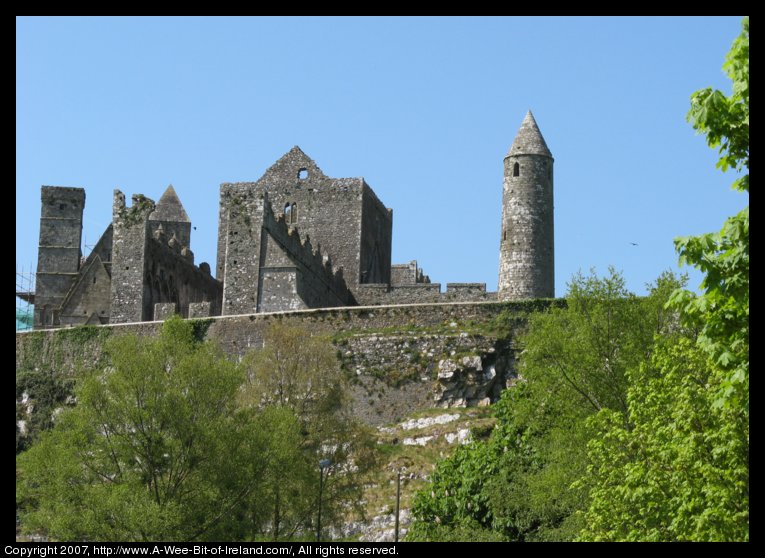Rock of Cashel
The Rock of Cashel has been a fortress or a religious site for thousands of years. The oldest building still standing is the round tower which is about 900 years old. It is also called Cashel of the Kings and St. Patrick's Rock. I also photographed the Rock of Cashel in January 2004.
The Heritage Ireland web page for the Rock of Cashel (retrieved July 30, 2018) says: http://www.heritageireland.ie/en/en/south-east/rockofcashel/A spectacular group of Medieval buildings set on an outcrop of limestone in the Golden Vale including the 12th century round tower, High Cross and Romanesque Chapel, 13th century Gothic cathedral, 15th century Castle and the restored Hall of the Vicars Choral. Attractions include an audio-visual show and exhibitions. Access for visitors with disabilities by prior arrangement.
Next photo of the Rock of Cashel.

The Catholic Encyclopedia at http://www.newadvent.org/cathen/11554a.htm says:St. Patrick next proceeded to Munster. As usual, his efforts were directed to combat error in the chief centres of authority, knowing well that, in the paths of conversion, the kings and chieftains would soon be followed by their subjects. At "Cashel of the Kings" he was received with great enthusiasm, the chiefs and Brehons and people welcoming him with joyous acclaim. While engaged in the baptism of the royal prince Aengus, son of the King of Munster, the saint, leaning on his crosier, pierced with its sharp point the prince's foot. Aengus bore the pain unmoved. When St. Patrick, at the close of the ceremony, saw the blood flow, and asked him why he had been silent, he replied, with genuine heroism, that he thought it might be part of the ceremony, a penalty for the joyous blessings of the Faith that were imparted. The saint admired his heroism, and, taking the chieftain's shield, inscribed on it a cross with the same point of the crozier, and promised that that shield would be the signal of countless spiritual and temporal triumphs.
AN ATHAR SEATHRUN CEITING, OLLAMH RE DIADHACHTA.
THE HISTORY OF IRELAND FROM
The Earliest period to the English Invasion
BY THE KEVEREND GEOFFREY KEATING D.D.
TRANSLATED FROM THE ORIGINAL GAELIC, AND COPIOUSLY ANNOTATED,
BY JOHN O'MAHONY.
WITH A MAP SHOWING THE LOCATION OP THE ANCIENT CLANS,
AND A TOPOGRAPHICAL APPENDIX
New York
(JAMES B KIRKER LATE EDWARD DUNIGAN & BROTHER)
599 BROADWAY UP STAIRS
1866
https://books.google.com/books?id=9yVpAAAAcAAJ&pg=PA407&dq=the+principality+of+Munster+was+ruled+by+Aengus,+son+of+Nadfraech.+Upon+Patrick%27s+entering+his+dominions&hl=en&sa=X&ved=0ahUKEwiviqz5y8fcAhWh1IMKHdytBaQQ6AEIKzAA#v=onepage&q&f=false is a link to a free ebook (retrieved July 30, 2018)In the reign of Laegari, son of Niall, while Patrick was sowing the Faith in Ireland, the principality of Munster was ruled by Aengus, son of Nadfraech. Upon Patrick's entering his dominions to preach therein, this Prince came to Magh-Femhenn, in the northern Desi, to welcome the holy man. Thence he brought him to his royal residence of Caisel (Cashel), situated in that part of the Eoganacht territory which is now called Trian-Medonach (Middletherd). The event is thus related in an old Latin life of the saint, which has fallen into our hands: "But as he was entering Momonia, the king of that country, Aengus Mac Nadfraeich, came to meet him on the plain of Femhenn, in the land of Desi, and led him joyfully into his royal city, by name Caisel, in the region of Eoganacht; and there King Aengus believed and was baptized." In the same place it is told that Patrick thrust the pointed end of his staff through the foot of Aengus upon that occasion. The fact is thus related: "As Patrick stood up and was giving his benediction to the king in a standing posture, the point of his holy staff was fixed in the royal foot." It must be understood from this, that it was not through the foot of Eogan, son of Niall, the King of Ulster, that Patrick thrust the spear of his pastoral staff, but through that of Aengus, son of Nadfraech, King of Munster. With this account, even one of the learned antiquaries of Leth Cuin, namely, Torna, son of Muiris 0'Mael Conari (Maurice O'Mulconry, or Conry), fully agrees, in the poem which begins with the line: "The bishop's blessing on Eber's seed." The following are his words:
Through the foot of Aengus -- dire the wound --
The point of Patrick's staff was thrust:
And the floor was flooded with his blood --
The fact is now no whispered tale.
This page is on a slow server. Please be patient while the pictures load.
Copyright 2007, A-Wee-Bit-of-Ireland.com
Shopping for wall art and this photo printed on other items: https://1-john-moyer.pixels.com/featured/rock-of-cashel-john-moyer.html
License this photo for your own commercial use: https://licensing.pixels.com/featured/rock-of-cashel-john-moyer.html
